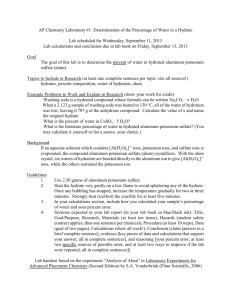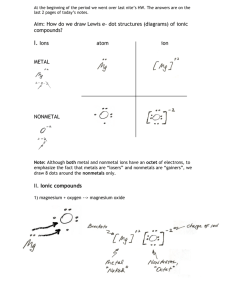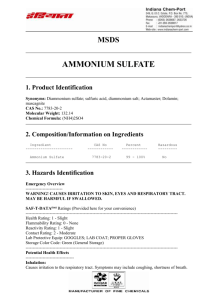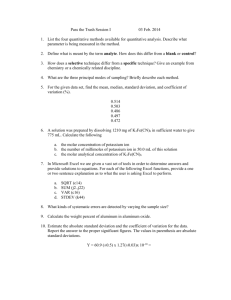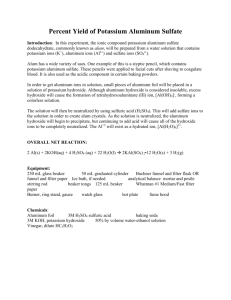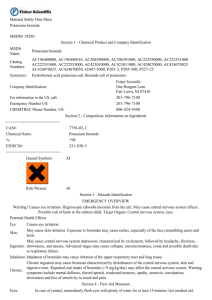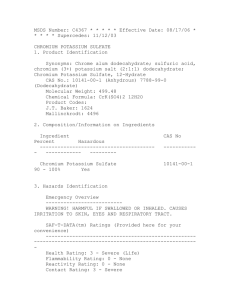MSDS Number: A2856 * * * * * Effective Date: 02/03/09
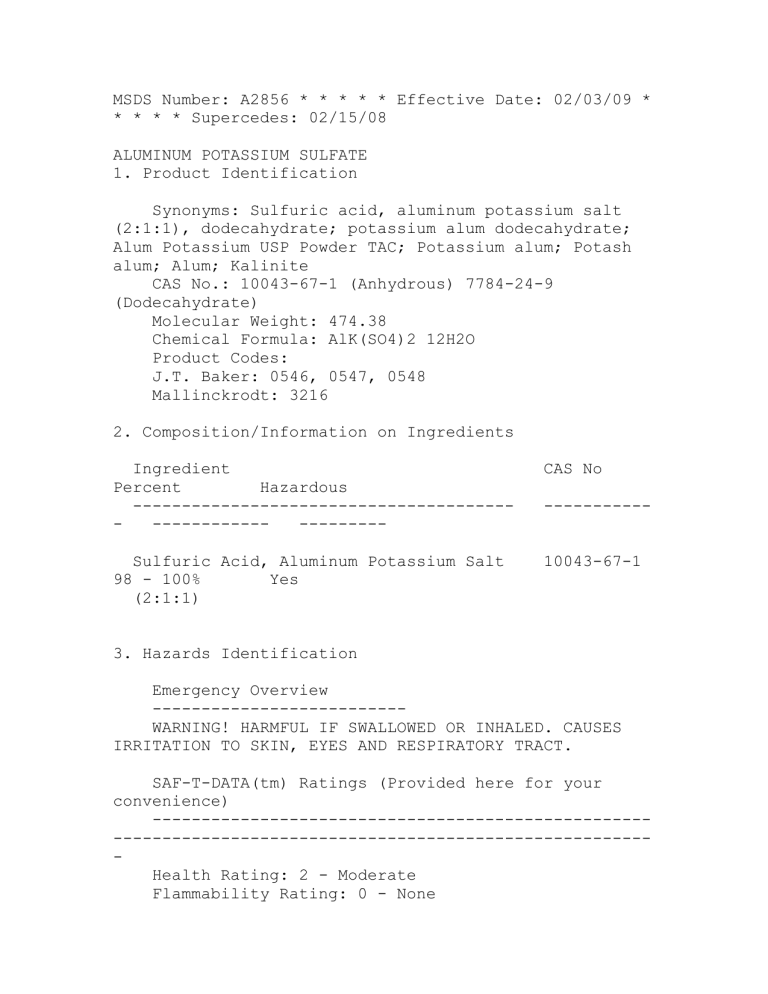
MSDS Number: A2856 * * * * * Effective Date: 02/03/09 *
* * * * Supercedes: 02/15/08
ALUMINUM POTASSIUM SULFATE
1. Product Identification
Synonyms: Sulfuric acid, aluminum potassium salt
(2:1:1), dodecahydrate; potassium alum dodecahydrate;
Alum Potassium USP Powder TAC; Potassium alum; Potash alum; Alum; Kalinite
CAS No.: 10043-67-1 (Anhydrous) 7784-24-9
(Dodecahydrate)
Molecular Weight: 474.38
Chemical Formula: AlK(SO4)2 12H2O
Product Codes:
J.T. Baker: 0546, 0547, 0548
Mallinckrodt: 3216
2. Composition/Information on Ingredients
Ingredient CAS No
Percent Hazardous
--------------------------------------- -----------
- ------------ ---------
Sulfuric Acid, Aluminum Potassium Salt 10043-67-1
98 - 100% Yes
(2:1:1)
3. Hazards Identification
Emergency Overview
--------------------------
WARNING! HARMFUL IF SWALLOWED OR INHALED. CAUSES
IRRITATION TO SKIN, EYES AND RESPIRATORY TRACT.
SAF-T-DATA(tm) Ratings (Provided here for your convenience)
---------------------------------------------------
-------------------------------------------------------
-
Health Rating: 2 - Moderate
Flammability Rating: 0 - None
Reactivity Rating: 1 - Slight
Contact Rating: 2 - Moderate
Lab Protective Equip: GOGGLES; LAB COAT; VENT HOOD;
PROPER GLOVES
Storage Color Code: Green (General Storage)
---------------------------------------------------
-------------------------------------------------------
-
Potential Health Effects
----------------------------------
This material hydrolyzes in water to form sulfuric acid, which is responsible for the irritating effects given below.
Inhalation:
Causes irritation to the respiratory tract.
Symptoms may include coughing, shortness of breath.
Ingestion:
Causes irritation to the gastrointestinal tract.
Symptoms may include nausea, vomiting and diarrhea.
There have been two cases of fatal human poisonings from ingestion of 30 grams of alum.
Skin Contact:
Causes irritation to skin. Symptoms include redness, itching, and pain.
Eye Contact:
Causes irritation, redness, and pain.
Chronic Exposure:
No information found.
Aggravation of Pre-existing Conditions:
No information found.
4. First Aid Measures
Inhalation:
Remove to fresh air. If not breathing, give artificial respiration. If breathing is difficult, give oxygen. Get medical attention.
Ingestion:
If swallowed, DO NOT INDUCE VOMITING. Give large quantities of water. Never give anything by mouth to an unconscious person. Get medical attention immediately.
Skin Contact:
Wipe off excess material from skin then immediately flush skin with plenty of water for at least 15 minutes. Remove contaminated clothing and shoes. Get medical attention. Wash clothing before reuse.
Thoroughly clean shoes before reuse.
Eye Contact:
Immediately flush eyes with plenty of water for at least 15 minutes, lifting upper and lower eyelids occasionally. Get medical attention.
5. Fire Fighting Measures
Fire:
Not considered to be a fire hazard.
Explosion:
Not considered to be an explosion hazard.
Fire Extinguishing Media:
Use any means suitable for extinguishing surrounding fire. Keep in mind that addition of water can cause the formation of sulfuric acid.
Special Information:
In the event of a fire, wear full protective clothing and NIOSH-approved self-contained breathing apparatus with full facepiece operated in the pressure demand or other positive pressure mode.
6. Accidental Release Measures
Cover spill with sodium bicarbonate or soda ash and mix. Ventilate area of leak or spill. Keep unnecessary and unprotected people away from area of spill. Wear appropriate personal protective equipment as specified in Section 8. Spills: Pick up and place in a suitable container for reclamation or disposal, using a method that does not generate dust.
7. Handling and Storage
Keep in a tightly closed container, stored in a cool, dry, ventilated area. Protect against physical damage. Isolate from incompatible substances.
Containers of this material may be hazardous when empty
since they retain product residues (dust, solids); observe all warnings and precautions listed for the product.
8. Exposure Controls/Personal Protection
Airborne Exposure Limits:
-OSHA Permissible Exposure Limit (PEL):
15 mg/m3 (TWA) total dust and 5 mg/m3 (TWA)
respirable fraction for Aluminum metal as Al.
-ACGIH Threshold Limit Value (TLV):
1 mg/m3 respirable fraction (TWA), Aluminum metal and Insoluble compounds, A4.
Ventilation System:
A system of local and/or general exhaust is recommended to keep employee exposures below the
Airborne Exposure Limits. Local exhaust ventilation is generally preferred because it can control the emissions of the contaminant at its source, preventing dispersion of it into the general work area. Please refer to the ACGIH document, Industrial Ventilation, A
Manual of Recommended Practices, most recent edition, for details.
Personal Respirators (NIOSH Approved):
If the exposure limit is exceeded and engineering controls are not feasible, a half facepiece particulate respirator (NIOSH type N95 or better filters) may be worn for up to ten times the exposure limit or the maximum use concentration specified by the appropriate regulatory agency or respirator supplier, whichever is lowest.. A full-face piece particulate respirator
(NIOSH type N100 filters) may be worn up to 50 times the exposure limit, or the maximum use concentration specified by the appropriate regulatory agency, or respirator supplier, whichever is lowest. If oil particles (e.g. lubricants, cutting fluids, glycerine, etc.) are present, use a NIOSH type R or P filter. For emergencies or instances where the exposure levels are not known, use a full-facepiece positive-pressure, airsupplied respirator. WARNING: Air-purifying respirators do not protect workers in oxygen-deficient atmospheres.
Skin Protection:
Wear impervious protective clothing, including boots, gloves, lab coat, apron or coveralls, as appropriate, to prevent skin contact.
Eye Protection:
Use chemical safety goggles and/or full face shield where dusting or splashing of solutions is possible.
Maintain eye wash fountain and quick-drench facilities in work area.
9. Physical and Chemical Properties
Appearance:
Colorless crystals.
Odor:
Odorless.
Solubility:
14% in water, 333% in boiling water
Density:
1.73
pH:
3.3 (0.2 M solution)
% Volatiles by volume @ 21C (70F):
0
Boiling Point:
ca. 200C (ca. 392F) Loses water
Melting Point:
92.5C (198F)
Vapor Density (Air=1):
No information found.
Vapor Pressure (mm Hg):
No information found.
Evaporation Rate (BuAc=1):
No information found.
10. Stability and Reactivity
Stability:
Stable under ordinary conditions of use and storage.
Hazardous Decomposition Products:
Hydrolyzes to form dilute sulfuric acid. Toxic and corrosive oxides of sulfur may be formed when heated to decomposition.
Hazardous Polymerization:
Will not occur.
Incompatibilities:
Corrosive to metals in the presence of water.
Conditions to Avoid:
Moisture and incompatibles.
11. Toxicological Information
Investigated as a reproductive effector.
--------\Cancer Lists\-------------------------------
-----------------------
---NTP
Carcinogen---
Ingredient Known
Anticipated IARC Category
------------------------------------ ----- -----
------ -------------
Sulfuric Acid, Aluminum Potassium No
No None
Salt (2:1:1) (10043-67-1)
12. Ecological Information
Environmental Fate:
No information found.
Environmental Toxicity:
No information found.
13. Disposal Considerations
Whatever cannot be saved for recovery or recycling should be managed in an appropriate and approved waste disposal facility. Processing, use or contamination of this product may change the waste management options.
State and local disposal regulations may differ from federal disposal regulations. Dispose of container and unused contents in accordance with federal, state and local requirements.
14. Transport Information
Not regulated.
15. Regulatory Information
--------\Chemical Inventory Status - Part 1\---------
------------------------
Ingredient TSCA
EC Japan Australia
----------------------------------------------- ----
--- ----- ---------
Sulfuric Acid, Aluminum Potassium Salt (2:1:1) Yes
Yes Yes Yes
(10043-67-1)
--------\Chemical Inventory Status - Part 2\---------
------------------------
--Canada--
Ingredient
Korea DSL NDSL Phil.
----------------------------------------------- ----
- --- ---- -----
Sulfuric Acid, Aluminum Potassium Salt (2:1:1) Yes
Yes No Yes
(10043-67-1)
--------\Federal, State & International Regulations -
Part 1\----------------
-SARA 302-
------SARA 313------
Ingredient RQ TPQ
List Chemical Catg.
----------------------------------------- --- ----
- ---- --------------
Sulfuric Acid, Aluminum Potassium Salt No No
No No
(2:1:1) (10043-67-1)
--------\Federal, State & International Regulations -
Part 2\----------------
-RCRA- -TSCA-
Ingredient CERCLA
261.33 8(d)
----------------------------------------- ------
------ ------
Sulfuric Acid, Aluminum Potassium Salt No
No No
(2:1:1) (10043-67-1)
Chemical Weapons Convention: No TSCA 12(b): No
CDTA: No
SARA 311/312: Acute: Yes Chronic: No Fire: No
Pressure: No
Reactivity: No (Pure / Solid)
Australian Hazchem Code: None allocated.
Poison Schedule: None allocated.
WHMIS:
This MSDS has been prepared according to the hazard criteria of the Controlled Products Regulations (CPR) and the MSDS contains all of the information required by the CPR.
16. Other Information
NFPA Ratings: Health: 1 Flammability: 0 Reactivity:
0
Label Hazard Warning:
WARNING! HARMFUL IF SWALLOWED OR INHALED. CAUSES
IRRITATION TO SKIN, EYES AND RESPIRATORY TRACT.
Label Precautions:
Avoid breathing dust.
Keep container closed.
Use only with adequate ventilation.
Wash thoroughly after handling.
Avoid contact with eyes, skin and clothing.
Label First Aid:
If swallowed, DO NOT INDUCE VOMITING. Give large quantities of water. Never give anything by mouth to an unconscious person. If inhaled, remove to fresh air. If not breathing, give artificial respiration. If breathing is difficult, give oxygen. In case of contact, wipe off excess material from skin then immediately flush eyes or skin with plenty of water for
at least 15 minutes. Remove contaminated clothing and shoes. Wash clothing before reuse. In all cases, get medical attention.
Product Use:
Laboratory Reagent.
Revision Information:
MSDS Section(s) changed since last revision of document include: 8.
Disclaimer:
*******************************************************
*****************************************
Mallinckrodt Baker, Inc. provides the information contained herein in good faith but makes no representation as to its comprehensiveness or accuracy.
This document is intended only as a guide to the appropriate precautionary handling of the material by a properly trained person using this product. Individuals receiving the information must exercise their independent judgment in determining its appropriateness for a particular purpose. MALLINCKRODT BAKER, INC.
MAKES NO REPRESENTATIONS OR WARRANTIES, EITHER EXPRESS
OR IMPLIED, INCLUDING WITHOUT LIMITATION ANY WARRANTIES
OF MERCHANTABILITY, FITNESS FOR A PARTICULAR PURPOSE
WITH RESPECT TO THE INFORMATION SET FORTH HEREIN OR THE
PRODUCT TO WHICH THE INFORMATION REFERS. ACCORDINGLY,
MALLINCKRODT BAKER, INC. WILL NOT BE RESPONSIBLE FOR
DAMAGES RESULTING FROM USE OF OR RELIANCE UPON THIS
INFORMATION.
*******************************************************
*****************************************
Prepared by: Environmental Health & Safety
Phone Number: (314) 654-1600 (U.S.A.)
